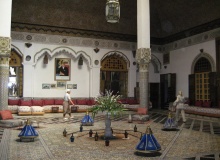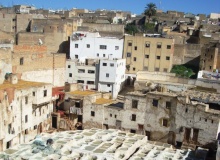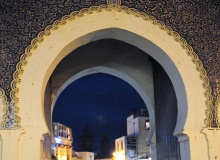Morocco
Casablanca | Marrakech | Fez
Morocco's dazzling mosaic of Arab and Berber cultures—with a dash of African and European influence—is at once strange and romantic, alluring and disconcerting. It's little wonder that Morocco has regularly drawn seekers of the exotic.
The country is one of Africa's most popular travel destinations. No matter how well-seasoned a traveller you are, you'll find plenty to see and do: fine Atlantic and Mediterranean beaches, desert excursions, wondrous imperial cities, Islamic landmarks, Joujoukan and Gnaoua trance music, Roman antiquities, resort facilities, mountain villages, oases and towering sand dunes. Just be aware that the combination of heat, dust, spicy flavours and intrusive touts can be overwhelming at times.
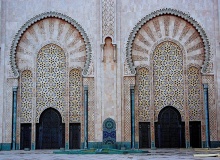
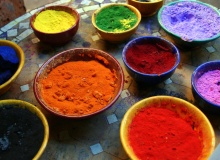
Casablanca
Well known because of the Humphrey Bogart film of the same name, Casablanca is Morocco's largest and most modern city. Before the French began to develop it as the country's economic capital in 1912, Casablanca was only a small trading post. Its subsequent rapid growth has wiped away most of its romantic image. Now basically a big commercial and industrial city, it is home to most of Morocco's major corporations and banks. However, its traditional markets pale in comparison with those of Fez or Marrakech.
Although Casablanca has a medina and boasts several landmark 1920s and 1930s buildings with art-nouveau, art-deco and traditional Moroccan accents, the most impressive sight by far is the Hassan II Mosque. It was completed in 1993 and is one of the largest mosques in the world. It is also one of only a few mosques in Morocco that non-Muslims can visit. Guided tours allow you to see the wonderful craftsmanship and furnishings: beautiful mosaic tile work, sculpted plasterwork, marble-clad walls and arches, thick carpets, and enormous Venetian glass chandeliers. The wooden ceiling above the immense prayer hall can retract to open the mosque to the sky.
WHEN TO TRAVEL to Casablanca
Whilst year round Morocco is warm and sunny, the best time to visit is from mid February to June and from September to December. Coastal Morocco is cooled by breezes off the Mediterranean and Atlantic. The peaks of the Atlas Mountains are snow capped for most of the year.
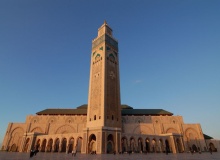
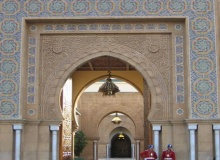
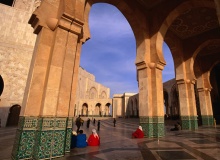
Marrakech
Marrakech is the most popular destination in Morocco. The setting is stunning, with ochre stucco buildings on a dry, rocky plain and the snow-peaked Atlas Mountains as a backdrop (they're not always visible). Much of the medina is surrounded by beautifully restored pinkish-red ramparts, and lovely palm gardens are interspersed among the impressive buildings, including an ever-growing number of nicely renovated courtyard mansions (riads) that now serve as boutique hotels. The modern Marrakech has gracious, wide avenues and large, resort-style hotels.
Marrkech’s vast square called Djemaa el-Fna is the main show in town. It's a market scene straight out of the movies, with snake charmers, musicians, acrobats and storytellers. At night, the plaza is filled with gaslit restaurant stalls and people enjoying the food and spectacle. If you'd rather not be in the thick of things, you can enjoy the atmosphere from one of the rooftop terrace restaurants overlooking the plaza. If you're longing for some nightlife, Marrakech has some very trendy clubs, such as Jad Mahal and Pacha.
WHEN TO TRAVEL to Marrakech
It is best to try and avoid the summer heat and crowds and visit Marrakech in the cooler months between September and May. But, some annual events take place in summer that you may not want to miss, such as the arts festival in July.
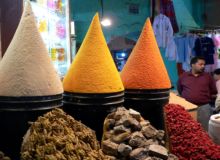
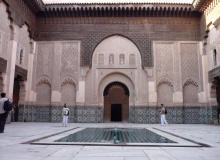
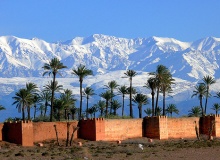
Fez
Fez has rightly been declared a UNESCO World Heritage site. Its walled medina is one of the largest, most intact and impressive medieval cities in the Arab world and, taken as a whole, it's the architectural highlight of Morocco. Fez also has a French-planned new city and the contrast between the old and the new sections makes sightseeing all the more fascinating. You truly feel as if you're stepping into the past when you walk through one of the gates to the old medina.
Popular spots in Fez for a panoramic view of the old city are Borj Sud (a ruined fortress atop a hill south of the medina) and the Merenid Hotel (north of the medina). The more distant view from the Zalagh Hotel in the new city is also very nice. The new city, by contrast, has a European feel, with wide streets and squares. Avenue Hassan II and Boulevard Mohammed V are the main thoroughfares there, and both are lined with restaurants, sidewalk cafes and pastry shops.
WHEN TO TRAVEL to Fez
The best time to visit Fez is from September to November and April to June. It's not too hot and there are fewer tourists. The Fez Festival of World Sacred Music is usually held in June and is certainly worth planning your trip around.
